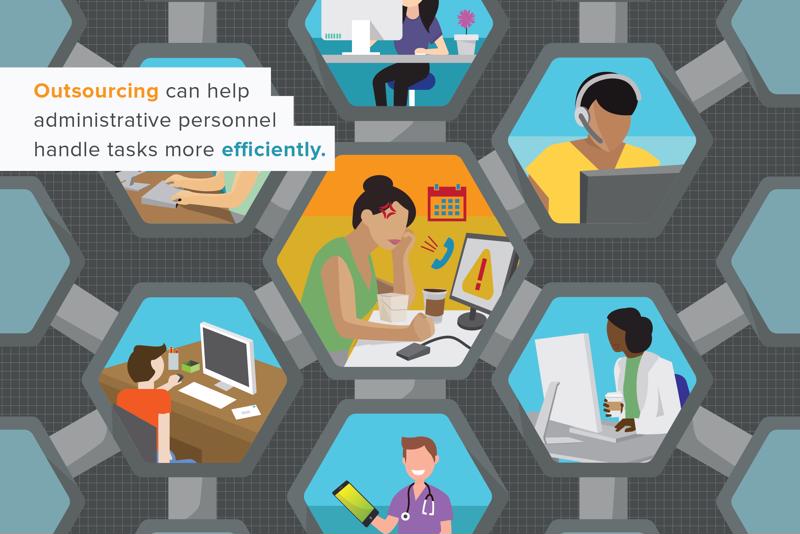Report: 98 percent of hospitals understand need for healthcare outsourcing
June 29, 2018
It’s become apparent to many hospitals that they need to outsource certain services.
The average hospital is overwhelmed with medical professionals and healthcare administrators alike constantly doing everything within their power to serve all patients in the best possible manner.
But within that environment, mistakes can be made and processes can be overlooked – more often than anyone with a passion for working in healthcare would want. When errors occur, they can often be attributed in whole or part to overexertion and exhaustion.
"Hospitals can notably benefit from the assistance provided by third-party outsourcing."
While understandable on a human level, hospitals can't afford to jeopardize patient care and experience in any way. Recent research points out in great detail the potential dangers of overextending administrative staff – as well as the possible benefits of outsourcing healthcare revenue cycle management and other functions.
Costs expected to steadily rise
Black Book Market Research found a great deal of compelling evidence that illustrates the value outsourcing can bring in the medical sphere, not least of which is cost reduction. This is particularly relevant given the finding that headlines its survey of leading healthcare management figures: By 2022, it's quite possible that hospitals will have to cut costs by at least 24 percent solely to break even on their expenses, let alone profit.
No matter what services may be cut, it's all but guaranteed that this would lead to a decline in the patient experience, thus potentially limiting the likelihood of patients trusting institutions with their health in the future, or recommending them to friends and family.
Also, with the State of Population Health survey by Numerof & Associates finding that 54 percent of healthcare organizations bring in only 10 percent of their income
through risk-based models, there is even more pressure on facilities to lower costs.

Most leaders at medical institutions understand that outsourcing some tasks is a must.
Tangible value to outsourcing
Among nearly all of the 709 managers, C-suite company leaders and other respondents to the Black Book survey, the need for outsourcing in healthcare was made perfectly clear, as 98 percent of them said they were either actively considering adopting such services or had already done so. Part of this, as noted by Black Book President Doug Brown, is the good reputation of outsourced services within the field.
"Outsourcing in the healthcare industry doesn't get the same bad rap other sectors experience such as banking, insurance, tech and call centers where negative stereotypes associated with offshoring and/or full functioning outsourcing were largely misinformed," Brown explained. "In hospitals, there is a developed understanding of the broad spectrum of outsourcing options and how to manage vendors."
Because of the cost-reduction potential inherent in outsourcing nonclinical responsibilities such as billing, some hospitals and clinics are adopting it for various clinical purposes as well. Some of these include operation of teleradiology and medical imaging equipment, as well as emergency care and anesthesiology.
PROMEDICAL has been an outsourcing partner with health systems and hospitals since 1995 to provide workers' compensation and motor vehicle accident billing. Leverage PROMEDICAL's technology and expertise to ensure proper reimbursement, timely resolutions, increased cash and a superior patient experience all while giving your staff more time to dedicate to other important responsibilities.

In 2016, healthcare vendors need the most efficient claims processing systems out there. By now, flexible, web-focused methods for important claims tasks are clearly the industry's path forward, and will play a major role in bridging the gap between patients and providers. A fast, digital claims method makes a direct link from implementation to delivery for workers' compensation and motor vehicle billing alike. Now is the time to invest in better revenue cycle management, with a focus on detail-driven, well-facilitated collection that breaks down barriers. Despite the growing pains involved with adopting any new technology, there are a couple of areas where smarter systems have already improved claims processing online. Direct accessibility With each new convenience, the future of healthcare looks more integrated. Data analytics harvests insights from seemingly unrelated details for fuller results. To make this innovation worthwhile, however, there needs to be a distinct pipeline between entities. "Data analytics harvests insight from seemingly unrelated details." Online healthcare portals are already addressing this need, providing direct communication through smart devices like phones and tablets. By bringing necessary information together in a simple, accessible source, these solutions set the stage for clean claims assembly. Shorter cycles Proper collection from the outset can reduce the amount of work hospitals have to do later if the claim is resubmitted, according to Gary Marlow, Vice President of Finance at Beverly Hospital and Addison Gilbert Hospital. "From a revenue cycle perspective, getting the most accurate information up front starts with patient scheduling and patient registration," Marlow told RevCycleIntelligence in 2015. "That provides the groundwork by which claims can be billed and collected in the most efficient and effective manner possible." The way information enters the claims process can impact how it gets managed. If technology, like artificial intelligence, is present at the beginning and guides the claims throughout, there's a consistent system handling the information the process to meet best practices. PROMEDICAL's benefits With our secure, efficient and comprehensive system, PROMEDICAL is staying ahead of the game. We're doing that by developing the following features: Communication: Users can choose from multiple languages with our online offerings. This allows you to customize your system to better reach patient populations and keep claims moving faster. Customization: If our proprietary options aren't currently meeting your needs, we can change them to do so based on feedback. Adapt to state fee schedules or language demands on a case by case basis. Encryption: A must for secure file exchange, PROMEDICAL ensures a secure file transfer process. Our process protects backup data equally strong as primary data, for efficient security across the board. Planning: Organizations also benefit when a set deadline is involved, putting clear limits on when submissions are set for review. Processing records requests within a preordained period of days helps managers know what to expect, and regular reports set up clear overviews of important statistics. Contact PROMEDICAL today to learn more about our healthcare revenue cycle solutions.

According to Pew Research, 15 percent of U.S. adults have used ridesharing services . Where does insurance enter the picture? Uber, Lyft and other ridesharing apps throw a proverbial wrench in hospitals' revenue cycle management operations. Billing is already a major pain point in hospitals – Black Book Research noted most facilities are outsourcing their RCM because in-house teams lack the resources to efficiently handle motor vehicle reimbursement. Ridesharing will only exacerbate the issue. For example, if a rider gets injured and has to go to the hospital, from which institution does the hospital receive reimbursement : The driver's insurance? The passenger's? Uber's? As Uber and Lyft are the most popular ridesharing apps, we'll focus on how these companies handle driver insurance. How do Lyft and Uber insure drivers? Lyft has three types of coverage within its insurance policies: Contingent Liability activates when a driver logs into the app and requests to accept rides – a state Lyft designates as "Driver mode." This coverage provides up to $100,000 per accident for bodily injury. Contingent Comprehensive and Collision kicks in when a driver has picked up a passenger. This coverage applies when a non-collision event damages the driver's vehicle. Uninsured/Underinsured Motorist applies when an at-fault driver who is uninsured or underinsured causes bodily injury to himself, his passengers or any third parties. The coverage provides $1 million per incident, and includes no deductible. For example, if a driver is injured in an accident at a time when he is not working for Lyft, his personal insurance will cover him (assuming he lives in a no-fault state, but that's another issue). However, when the driver activates Driver mode, Lyft's Contingent Liability will protect him even if he hasn't accepted a ride from a passenger. What if the driver's at fault? According to Rideshare Dashboard, Lyft's commercial insurance will cover all damages to third parties and the passenger, but the driver will have to cover his own medical expenses. That's when state laws dictate payment. In Massachusetts, for example, which also happens to be a no-fault state and requires all motor vehicle owners to possess auto insurance, the rider's personal auto insurance will cover the medical bills. Uber's insurance system is somewhat similar to Lyft's but possesses a few minor differences. For example, when an Uber driver is transporting a passenger, and another motorist causes an accident that results in bodily injury to the driver, the passenger and anyone else involved, Uber's UM/UMI will cover bodily injury of anyone in the rideshare vehicle.

With new, transformative technological advancements on the rise, it's no surprise that nearly every industry is feeling the impact of the digital age. From a healthcare provider's perspective, new resources can be used to revamp the current revenue cycle management processes you have in place. To reap the benefits of an optimized approach, you must be willing to take advantage of such emerging technological tools and resources, as stated by Chad Sandefur, Director and Healthcare Analyst at AArete. "Generally speaking, in order to strengthen the revenue cycle management, embracing technology within the revenue cycle is key," Sandefur shared with RevCycleIntelligence.com. "Having the platforms to seamlessly facilitate provider-payer interactions are really integral. In many cases, it's mostly about bad debt avoidance. With that in mind, there are a few specific points." Let's take a closer look at the benefits of utilizing technology, plus some of the emerging resources your facility can use to revamp your current RCM processes: The benefits of an optimized approach By paying attention to the new digital advancements that can benefit your RCM, you can ultimately impact the workflow of your staff members while better streamlining services for consumers. Here are some of the advantages of an optimized approach: Reduced chance for human error – Human error is inevitable when handling large amounts of data. Management software can be used to keep track of patient data input and maintenance. Better opportunity for precise, automated data entry – Between appointment scheduling, data input and claims submission, employees have a lot of duties. Automated software can take care of some of these responsibilities, allowing staff members to better focus on a single task at a time. I ncreased cash flow – Claims management technology can expedite claims quickly and produce clean, accurate claims, ultimately increasing cash flow , as stated by Becker's Hospital Review. Optimizing your RCM approach can lead directly to a significant return on investment and improve the overall reputation of your billing department.
